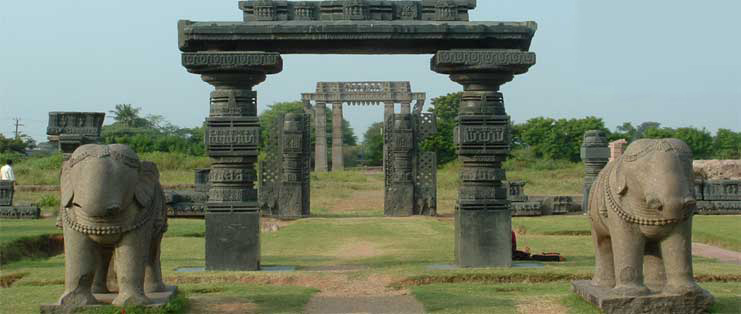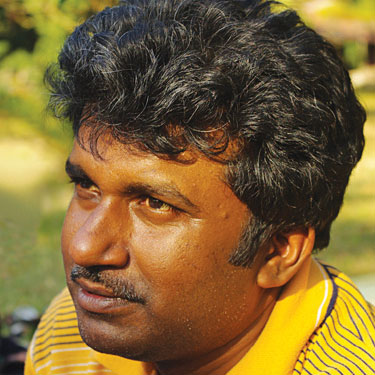
Warangal seldom seems to make it onto a tourist itinerary unless your kid is a student of the prestigious National Institute of Technology (NIT), Warangal. The entry to this top engineering college in India is marked with an ancient looking gateway and as one moves deeper into the town one finds that the power station, government buildings and even residential buildings have the strange ancient looking gateway.
Warangal Fort
These gates are the replicas of the gateways of the Warangal Fort, the seat of the power of the mighty Kakatiyas, who ruled over large portions of South India for over 300 years (1083 AD – 1323 AD). No wonder the Warangal Fort is the centre of attraction of Warangal town.
Warangal was the second capital of the Kakatiyas. In the 12th century AD, King Ganapati Deva shifted the capital from Hemankonda to Warangal and transformed the brick built Warangal Fort into a mighty stone citadel. His successors Queen Rudramadevi and King Paratrudra made several extensions, including bastions and protective walls. But during the invasion of Khiljis (1296) and Tughlaqs (1323) the mighty Warangal Fort crumbled like a pack of cards. The fort later acted as an outpost for the Tughlaqs and later for the Qutab Sahi dynasty.

Today the excavated ruins of the Warangal Fort are converted into a giant open air museum. It is maintained by the Archaeological Survey of India (ASI). Four giant gateways (same as the one in NIT) stand as sentinels to the complex.
The star attraction of the Warangal Fort is the Swayambhu Shiva Temple. Demolished by the Islamic invaders, it has been recreated piece by piece by the ASI. The majestic temple reminds one of the glorious days of the Kakatiyas.
Swayambhu, which literally means “born out of its own” has an interesting legend. Once during the Kakatiya rule, the wheel of a bullock cart got stuck in the mud. The villagers in the process of pulling it out revealed a Shiva Linga and hence the name Swayambhu.

Legend also claims the Warangal Fort once housed 365 Shiva temples, one for each day. Sadly today, only one reconstructed temple is all that remains of the golden days of the Warangal Fort.
Although in ruins, traces of remarkable artwork can still be spotted on the scattered stone sculptures. Stone statues of Ganesh and Durga (Mahishasura Mardini) lie scattered in the complex. Intricately carved relief work of dancing girls, along with floral and geometric patterns are found in abundance among the ruins.
Since the fort later served as an outpost for the Tughlaqs and Qutab Sahi dynasties it has its share of Islamic elements too. Kush Mahal, located a short distance away from the open air museum is the most well preserved Islamic structure of the fort. It’s a huge hall and today houses several statues recovered from the surrounding areas.
Recently, Andhra Pradesh Tourism Development Corporation (APTDC) has started a Sound and Light show at the Warangal Fort. The 50 minute show is in English and Telugu, which is the local language. The show mesmerises the audience and transports them back to the days of Kakatiyas.

The Thousand Pillar Temple
The thousand pillar temple, located in the heart of Warangal town, is the next stop. It was built by the Kakatiyas, who were great patrons of culture, art and architecture. Contrary to its name the temple has only 300 pillars and was built by Rudradeva in 1163 and is dedicated to Rudreshwara Swamy, an incarnation of Shiva.
There are three shrines inside the 100 pillar temple complex known as Trikutalayam, the other two shrines are dedicated to Vishnu and Surya. The complex also houses a Nandi Mandap, where the Nandi bull stands guard to the entire complex.
The walls and the pillars of the 1000 pillar temple, along with the other shrines in the complex, contain intricate stone carvings, depicting gods and goddesses to rows of elephants.

The last but not the least attraction of Warangal Town is the Bhadrakali Temple, located on the banks of the Bhadrakali lake. The temple is said to be founded by King Pulakesi II of Chalukya dynasty and later the Kakatiyas adopted Goddess Bhadrakali as their kuladevata (family deity). An active temple, the structure of the Bhadrakali Temple has been modified and nothing much remains of its ancient elements. A huge statue of Shiva and Parvati, located high up on the rocks, welcomes pilgrims and visitors to the temple. The complex has several other shrines and the huge manmade lake of Bhadrakali creates a soothing atmosphere for pilgrims and visitors alike.
The attractions of Warangal are not restricted to the town itself, but are spread over the entire district of Warangal. From ruined temples to huge manmade lakes and from dying art to long hanging bridges, the district of Warangal has something to offer to every tourist and traveler.
Ramappa Temple

A dozen elegant female dancers striking different poses will welcome you to the temple. Each with their flowing clothes, intricate jewellery and not to mention the amazing facial expression will be part of the grand entry at Palampet.
The gateways of the Ramappa
Temple are flanked by statues of dancing girls (known as Mandakinis) made out of black basalt, polished to perfection.Each of the three gateways of the temple are flanked by a pair of dancing girls on each side, thus having four dancing girls per gate which totals the number of dancing girls to twelve. The temple is located in the Palampur village of Warangal district in Andhra Pradesh. It is approachable by road from both Warangal (77 km) and Hyderabad (157 km). Built in 1213 by General Recherla Rudra during the reign of Kakatiya ruler Ganapati Deva, the temple is named after the chief architect Ramappa.
The Kakatiyas became a dominant power in Andhra Pradesh at the same time as the Hoysalas emerged in Karnataka. Both the dynasties were great patrons of architecture with very similar architectural style.
Their temples consisted of star shaped mandapas with projected porches and balcony seating along with lathe turned multifaceted pillars.
The main structure of the Ramappa Temple complex is known as Ramalingeswara and is dedicated to Lord Shiva. It stands on an elevated star shaped platform of height 6 feet.
The Ramalingeswar Temple consists of a garbhagriha, an antarala and a maha mandap. It consists of three entrances flanked with the dancing Mandakinis. The sand stone built temple is crowned with a spire (vimana) built of light bricks, so light that it is said to float in water. The interior of the temple is supported by pillars with exquisite carvings. The entrance of the inner sanctum is also elaborately carved out of basalt stone, so is the ceiling.
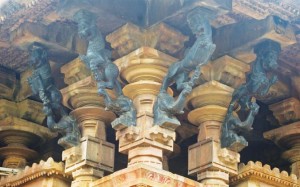
The other wall contains exotic sand stone carvings depicting lines of elephants striking different poses, lotus motifs, mythical animals along with images of Ganesha, Narasimha and other gods and goddesses. The temple also contains erotic freezes! The star attraction of the Ramappa Temple lies in its bracket figures carved out of black basalt stone which are polished to perfections.
The bracket figure at the three entrances represents the Mandakinis while the other bracket figures represent the mythical creatures Yalis.
The compound enclosed by high walls contains several other ruined structures including two other similar smaller structures on either side of the main temple. These two structures also dedicated to Lord Shiva are known as Kameswara and Kateswara. The compound also contains several other structures including a rock edict and the Nandi mandap. Although the roof of the Nandi mandapas collapsed long ago, the idol of the bull has remained completely intact.

By some strange magic it has survived the successive Islamic invasions, natural calamities and not to mention the years of human neglect. The Nandi seems to be in an alter position, ready to charge at the orders of Lord Shiva. The entire region near the Ramappa Temple contains several other ruins dating back to the days of Kakatiyas. The region also contains the Ramappa lake, a huge water body dug out by the Kakatiyas, which offers boating facilities to the tourist.
Ghanpur group of temples

The scattered ruins of the Ghanpur Temple complex, locally known as Kotagullu, looks like a huge open air museum. Although lesser known than the nearby famed Ramappa Temple of Palampet, the ruined Ghanpur Temple complex should be a must visit for tourists visiting Warangal. The Ghanpur groups of temples were probably constructed by Ganapati Deva of Kakatiya dynasty in the early 13th century.The Kakatiyas became a dominant power in Andhra Pradesh at the same time as the Hoysalas emerged in Karnataka. Both the Hoysalas and Kakatiya dynasties were great patrons of architecture with very similar architectural style, leading to the construction of several temples, spread over the modern day Karnataka and Andhra Pradesh. Ghanpur, once the citadel of power of the mighty Kakatiya dynasty, was plundered during the invasion of the Giyasuddin Tughlaq in 1323.In spite of the severe damage the temple survived and even after years of human neglect and nature’s toll the spectacular Ghanpur group of temples can still be seen to this day.
Located about 65 km south west of Warangal, the group of temples has been restored by the Andhra Pradesh State Archaeology Department. The dilapidated temple complex consists of 22 structures, of different shapes and sizes, enclosed within a doubled walled complex. Sadly the entrance of the Ghanpur group of temples is not marked with a board, depicting the brief history of the structures.

Six small Shiva shrines welcome visitors to the ruined complex. In spite of its ruined state the group of temples seems to be a symphony of scattered stones. The main Shiva Temple at the centre is the prime attraction. Built on a high star shaped platform the roof of the temple has long collapsed.
A sole Nandi bull, at the centre of the courtyard, remains the only witness to the glorious days of the Kakatiya dynasty. The main shrine also contains bracket figures of Yalis and Mandakinis, but they lack the grace and beauty of those in the Ramappa Temple. The east facing main shrine also contains exotic freezes, including an intricately carved granite door frame leading to the inner sanctum. The walls contain several sandstone freezes of elephant and lotus.
The main Shiva shrine is flanked on either side by two structures; to the North lies another Shiva shrine and to the South lies a mandapa. The roof of the mandapa has survived the test of time and remains intricately balanced on tumbling pillars. Each of the pillar consists of three sections, consisting of square, octagonal and circular parts. Some of the squared sections contain sculptured panels.
Two sculptures of Shiva and Vishnu, probably excavated from the temple complex, stand guard at the entrance of the mandapa. The complex also contains several other structures, including the six minor Shiva temples at the entrance.
Kolannupaka
The village of Kolannupaka houses a 2000-year-old Jain temple. Andhra Pradesh is also known for its rich Buddhist heritage but the state hardly promotes it. The Jain temple in the midst of a Hindu and Buddhist stronghold appears totally out of the blue. The temple has been renovated in the recent years by 150 artisans from Gujarat and Rajasthan. The temple with intricate sandstone sculptures and mosaic works has remarkable resemblance to the famous Dilwara Temple of Rajasthan. Sadly photography is totally prohibited in the temple complex.

Kolannupaka also houses the ruins of the Someswara Temple. The 1000-year-old temple has not survived the test of time but the ASI has converted the temple complex into an open air museum, containing amazing sculptures. The site also contains a buried Shiva lingam along with a Nandi bull and a step well.
Cherial scroll paintings
The tourist attraction of Warangal district is not restricted to ruined temples only. The non-descriptive village of Cherial boosts an art form, which dates back far beyond the days of the Kakatiyas.

Cherial, located in between Hyderabad and Warangal, looks like any ordinary Indian village. Unlike Raghurajpur (Orissa) and Naya (West Bengal) the houses in Cherial are not decorated with hand painted scrolls. Also unlike Raghurajpur and Naya, the entire Cherial village does not practice the art of scroll painting. In Cherial only a couple of families practice this age old art.
D. Vaikuntham, a national award winner, and his brother D. Nageshwar, a state award winner, not only practice the age old art of scroll painting, but have also modernised it by giving it different dimensions. Their small studio looks haphazard, as they normally do. From the walls hang scrolls of all sizes, with their intricate artwork with bright shades of paints.

Scroll painting is one of the earliest forms of audio – visual entertainment. Hundreds of years ago, the story telling community of Kaki Podagollu used to travel through the villages of Telangana, singing and narrating stories using the scroll as their visual aid. A scroll measures about three feet in width and can extend over 40 feet. It contains about 40 to 50 panels, each depicting a part of the story and would be displayed as the story unfolds.
The story, which is in the form of songs, is often accompanied by dolls, which makes it a total audio-visual package. The scroll painting of Rajasthan, Orissa and West Bengal focus mainly on religious aspects and mythology, and this is where the artists from Cherial differ. Their work is mainly focused on community specific storyline. In Cherial, the painters as well as the narrators, focus on day-to-day lives of communities like fishermen, toddy tappers, cobblers, fruit gatherers, etc. The scrolls also depict the legends and mythologies of the communities along with their Gods and heroes. Irrespective of the community or profession, each Cherial scroll starts with a panel of Ganapati, the god of beginnings and good fortunes, followed by Saraswati, the goddess of learning.

It is customary for the artist to seek blessing of the deities, in order to ensure that the art flourishes without any obstacles. The Cherial scroll painting is drawn on hand made khadi cloth specially processed with applying a paste of tamarind seed along with a tree gum and white clay. Three coats of the paste are applied, allowing a day in between for the paste to dry. Once the scroll is ready, the artist draws the outline, using a squirrel haired brush, in a phased manner.
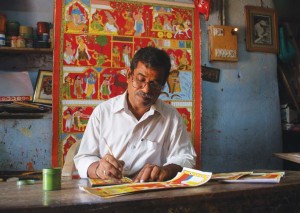
The colours used in the Cherial scroll painting follow a predetermined system. The striking red colour fills the background. The colour of the face and skin is decided by the nature of the character, like blue and yellow are for gods and goddesses respectively. Brown or darker shades are for demons, while pink and skin tones are for humans. In the past, natural dyes were used. White was obtained from grounded sea shells, black from lamp soot, yellow from turmeric, blue from indigo and the others from various vegetable dyes and grounded stones. Today, the natural dyes have largely been replaced by commercial organic water colours, which are mixed with tree gums before being applied on the scroll. The water colour- based Cherial scrolls are said to last over 300 years, provided they don’t come in contact with water.

Apart from the scrolls, the Cherial artists also make dolls and masks. The smaller masks are made of coconut shell while the larger ones are made out of sawdust and tamarind seed paste.
The Cherial dolls are made of light wood called tella puniki and are smeared with saw dust and tamarind seed paste. Like the scroll, both the dolls and masks have bright colours.
Today the Cherial scroll painting art still flourishes, but with the advent of other forms of audio–visual entertainment and with the dwindling numbers of story tellers and balladeers, the Cherial artists are forced to modify their art form.The long elongated scrolls are made smaller to fit in the walls of modern day drawing rooms and masks and dolls are customised into drawing room artifacts.
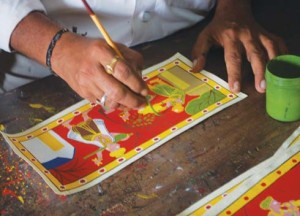
Cherial paintings have made their way on gift boxes, pen and candle stands and even on textiles. Cherial dolls have been transformed into decorative key chains. It is a great wonder that the art of Cherial scroll painting is alive, despite the numerous challenges. The passion of Cherial artists has helped to preserve a valuable piece in India’s rich cultural mosaic.
Prembarti metal works
Warangal also has its share of metal craftsmen. The brass artifacts of Prembarti are famous not only in India but throughout the world. These metal artifacts have made their way to the world famous hotels of New York and also to the corporate houses of Tokyo. The small village of Prembarti on the Hyderabad – Warangal Highway (100 km from Hyderabad and 60 Km from Warangal), is lined up with metal work workshops. For generations, the metal artisans of Prembarti are shaping brass and copper into finely crafted objects of art. Unlike Cherial, in Prembarti, the entire village seems to be involved in the art of metal carving. Almost each house consists of a small workshop and a showroom. The thud of the hammer hitting the metal can be heard from every household.
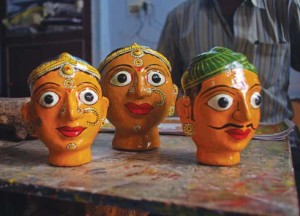
Prembarti village is also regarded as a center of brass work in India. The metal crafts and brass wares made here are exported to various foreign countries. Before the introduction of the metals, stone was the only medium of expression, and the ruined temples of Warnagal are a constant reminder of the glorious days of stone carvings. Later, when metals like, brass and copper came into use many people started using and experimenting with this material. According to some scholars, Prembarti played a pioneering role in the development of brass and metal works.
Initially the artifacts of Prembarti were restricted to images of gods and goddesses, but with the passage of time the artisans modified their creations to suit the taste, of not only the modern Indians, but also of international clients. Now the brass works of Prembarti have been modified into modern decorative items. Commemorative metal shields and trophies, statues, metal castings, candle stands, gift boxes, and a variety of small artifacts ideal as gift items have a large demand. Also in demand are brass figures of national leaders like Mahatma Gandhi and Swami Viveknanda. Mythological scenes from the epics of Ramayana and Mahabharata are still in demand and so are the beautiful calligraphed verses from the holy Koran.

key ring
Fortunately, efforts are made by the artisans of Prembarti to preserve the art, as it is being passed on to the future generation, and unlike the Cherial scroll paintings, Prembarti brass work art is flourishing.
Laknavaram Lake
The tourist attractions of Warangal are not restricted to only art and history; it has its share of nature too! The entire region between Hyderabad and Warangal is dotted with lakes. The lake of Laknavaram is located 78 km from Warangal. The island on this giant lake of Laknavaram has been connected to mainland by a set of twin hanging bridges and has been converted into a tourist spot by APTDC.
An APTDC tourist lodge, along with a glass walled a/c restaurant facing the lake, stands on the island. APTDC is also planning a cluster of resorts spread over the different islands of Laknavaram Lake. Presently there are options of boating and hiking.

Orientation
The tour is best done with Warangal town as the base. However there are staying options in Ramappa and also Laknavaram. Tourists who have time in hand and are looking for solitude can definitely spend a night each in the APTDC tourist lodge in Ramappa (Ph.: 0871 5200200, M: 0 99481 00450) and Laknavaram (0 88970 65307).
Warangal has several hotels to suit all budgets, including Haritha Kakatiya (Ph: 0870 2562236/37) of APTDC. The town is also well connected from Hyderabad by road.
A suggested itinerary assuming one starts from Hyderabad early:
Day 1: Start early from Hyderabad. Stop at the Cherial village to see the scroll paintings and at Prembarti village for metal crafts. Also visit the Jain and Shiva temples in Kolannupaka. Have lunch on the way and head towards Warangal and check into a hotel and have a night halt.
Day2: Start early, head for the Ramappa Temple and then to Ghanpur group of temples. Finally for Laknavaram Lake for lunch and boat ride. Get back to Warangal for night halt.
Day 3: Visit Warangal Fort and Thousand Pillar Temple. Back to hotel for lunch. Leave for Hyderabad.
Things to buy: Framed Cherial painting and Cherial artifacts. When to visit: Warangal can be visited throughout the year, but its best to avoid the monsoon season.
Festival: Kakatiya Festival is held every year during winter, and cultural events are held in the temple
and fort complexes.

